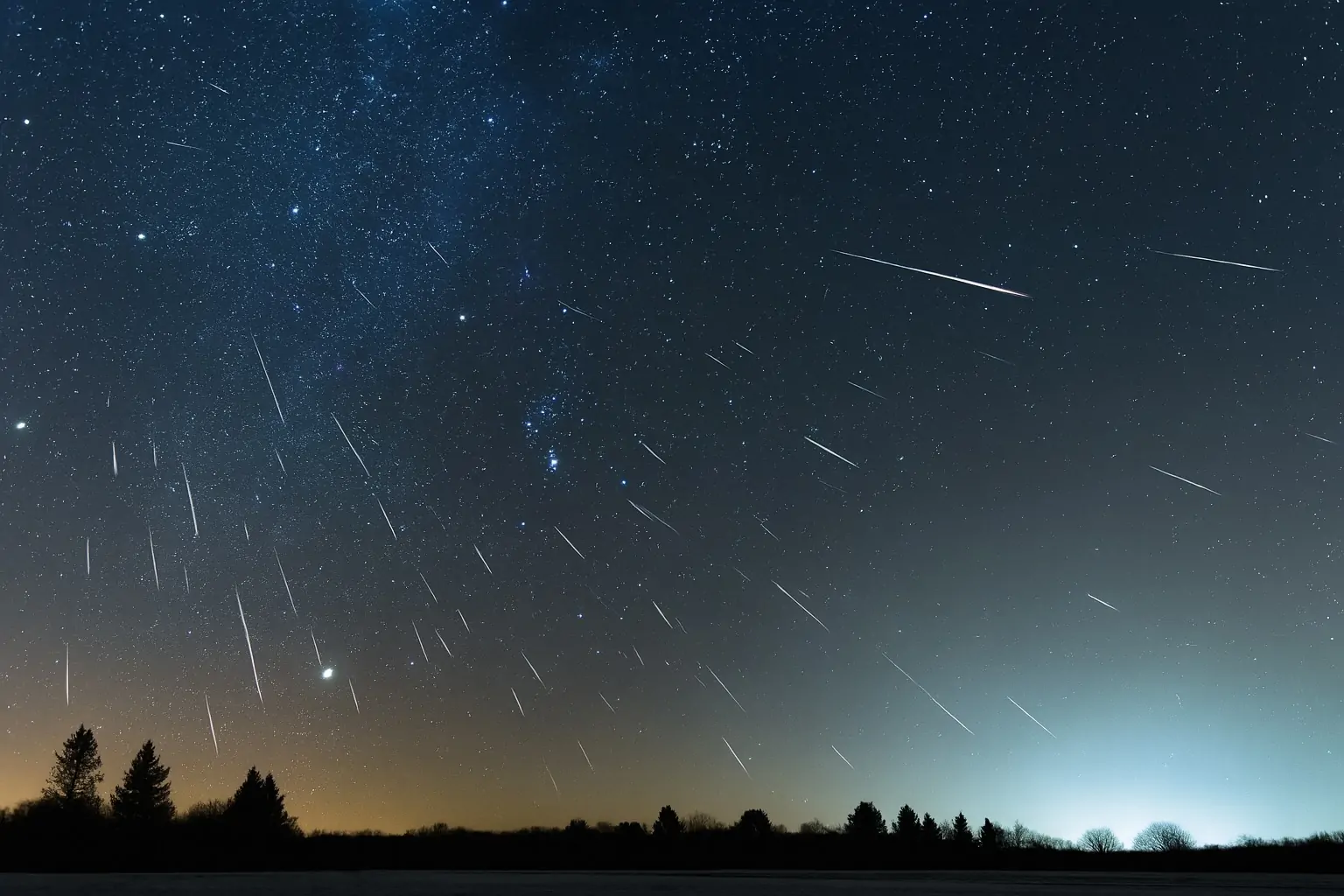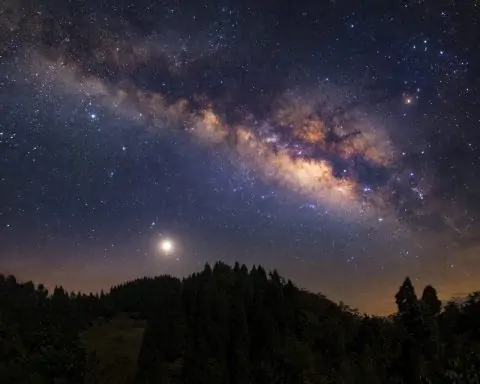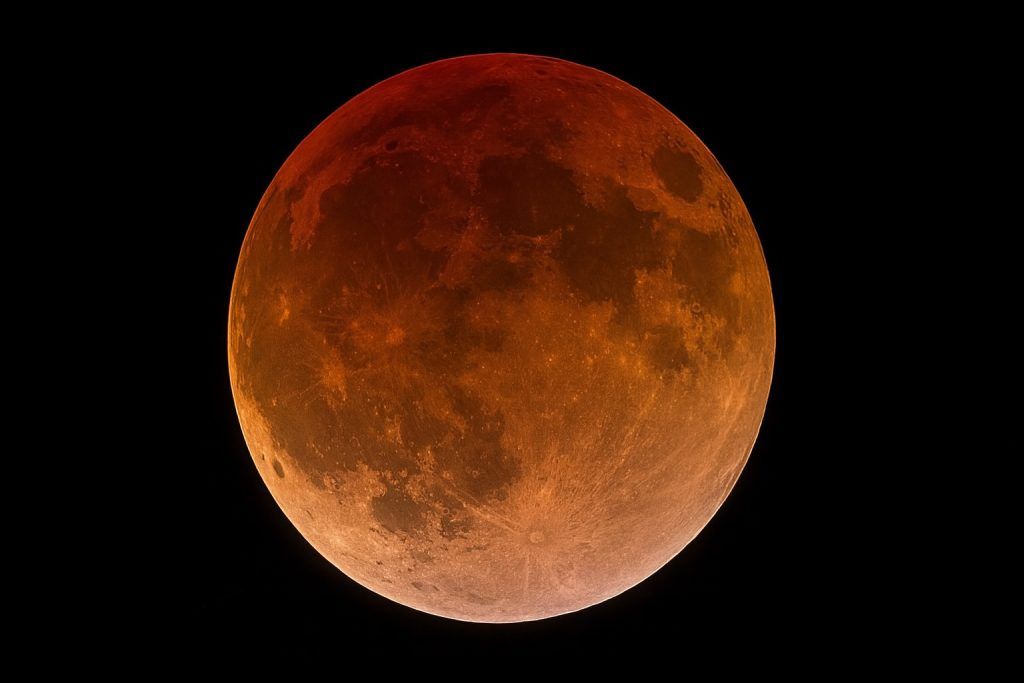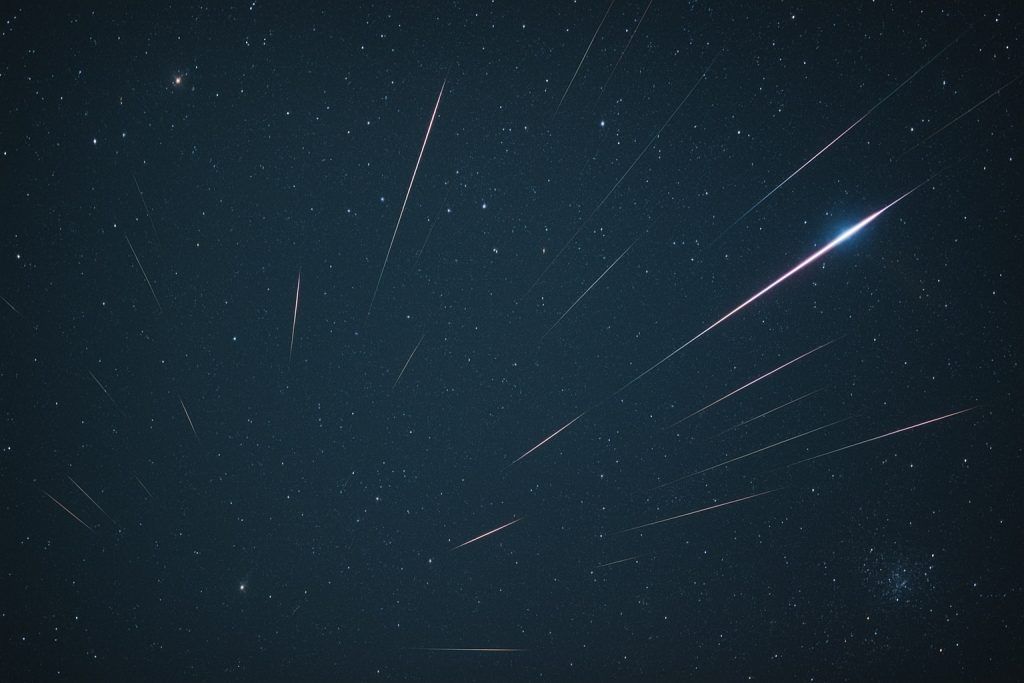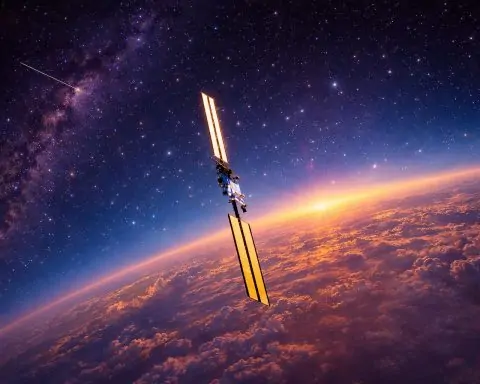- The Draconid meteor shower peaks around October 8, 2025, but a full Moon on October 6–7 will wash out most meteors, making outbursts of hundreds to thousands per hour unlikely, and its parent comet is 21P/Giacobini-Zinner.
- The Orionids peak on the nights of October 21–22, 2025, producing about 20 meteors per hour under dark skies from Halley’s Comet debris, with a near-new Moon (~2% illumination) aiding viewing.
- The Harvest Moon and first Harvest Supermoon of 2025 occurs on October 6, 2025, when the full Moon reaches peak fullness at 11:47 p.m. EDT near its perigee.
- Saturn remains a prominent evening object in October 2025 in Pisces after its September opposition, with rings nearly edge-on and a Moon close approach on October 5.
- Jupiter brightens toward its opposition in late November 2025, rising after 9 p.m. by mid-October, with a Last Quarter Moon near Jupiter on October 13–14 showcasing its four Galilean moons.
- Venus dominates the pre-dawn sky in October 2025 at about magnitude −4.5 with a ~40° elongation from the Sun, and a Venus–Moon pairing is notable around October 19.
- Mercury reaches its greatest eastern elongation of 23° on October 29, 2025, marking the last evening apparition of 2025 and a brief view 30–45 minutes after sunset.
- Comet C/2025 A6 Lemmon may reach magnitude 8 by October 21, 2025, with potential brightening to magnitude 3–5 near perihelion on November 8, 2025, visible from the Northern Hemisphere after sunset.
- Interstellar Comet 3I/ATLAS (C/2025 N1) will pass closest to the Sun around October 30, 2025 at about 1.4 AU and is unlikely to be visible in October, but should reemerge in the morning sky by early December 2025.
- The Taurid meteor complex includes Southern Taurids active October 13–November and Northern Taurids later in October, with about 5 meteors per hour and a higher chance of bright fireballs, plus a potential Taurid swarm in early November.
October 2025 is packed with celestial sights, from meteors and a brilliant supermoon to planets on the move and even a rare interstellar visitor. Whether you’re a casual stargazer or a seasoned astronomer, there’s something for everyone to enjoy in the night sky this month. Below we outline all the major skywatching events of October 2025 – meteor showers, a Harvest Supermoon, prominent planetary conjunctions, visible comets, and even heightened aurora activity – along with expert commentary and tips on when and where to look. Grab your calendar and mark these dates!
Meteor Showers in Early and Late October
The Draconids – Dragon Meteors Under a Bright Moon
The Draconid meteor shower peaks around October 8, 2025, but this year the “Dragon” will have its fire stolen by moonlight. The Draconids are a minor shower (often only ~10 meteors per hour under dark skies [1]), and unfortunately a full Moon on October 6–7 will flood the night sky with light during the peak [2]. The bright moonlight will wash out all but the brightest Draconid meteors, making them hard to spot. Best chance to catch a few “shooting stars” from Draco’s radiant (near the Dragon’s head in the northern sky) is as soon as darkness falls on October 8, before the Moon rises too high [3]. This unusual timing – evening instead of predawn – is because Draconid meteors fly in the early night hours (the shower’s radiant is highest in the sky at nightfall) [4].
Why bother with a faint shower? The Draconids are infamous for occasional outbursts. In rare years, if Earth passes through a dense clump of debris from the shower’s parent comet (21P/Giacobini-Zinner), the Draconids have surprised observers with hundreds or even thousands of meteors per hour (notably in 1933 and 1946) [5] [6]. Most years are quiet, but the comet did reach perihelion (closest approach to the Sun) in March 2025, raising the possibility of enhanced activity [7] [8]. “Watch out if the Dragon awakes!” writes one skywatching columnist – that slim chance of a meteor storm keeps many enthusiasts outdoors even in moonlight during this shower [9]. While a storm is not expected, keep an eye on the northern sky on October 8–9 just in case. (The Draconids favor observers in the Northern Hemisphere; those far south won’t see much, as Draco sits low or below the horizon.)
The Orionids – Halley’s Comet’s Encore
Later in the month comes the Orionid meteor shower, peaking on the night of October 21–22, 2025. The Orionids are debris from the famous Halley’s Comet and are known for fast, fine meteors. In a typical year, the Orionid shower produces about 20 meteors per hour at peak under clear dark skies [10]. Some years have surged higher (50–70 per hour in exceptional displays), but recently Orionids have been modest, around 20–30 per hour [11]. Fortunately, conditions in 2025 will be nearly ideal: the peak falls under a new Moon, so no moonlight will interfere [12]. In fact, the Moon will be only ~2% illuminated and rises near dawn, essentially leaving the late-night sky perfectly dark [13] [14] for meteor spotting.
The best time to watch is after midnight until pre-dawn on Oct. 21/22, once the constellation Orion (the shower’s radiant near Orion’s Club) climbs high. Orionids are swift – striking Earth almost head-on at 66 km/s – which often yields long, quick streaks [15]. They can appear anywhere in the sky, so find a dark location, lie back, and scan around Orion and the neighboring constellations. This shower is visible from both the Northern and Southern Hemispheres, as Orion straddles the celestial equator [16] [17]. NASA notes that the Orionids’ parent, Halley’s Comet, also causes the Eta Aquariids in May – making Halley “a two-for-one deal” for meteor fans each year [18]. With no Moon to spoil the show in 2025, experts predict excellent viewing conditions, so this could be one of the top meteor showers of the year [19].
Tips: Give your eyes 20–30 minutes to adapt to the dark, and avoid looking directly at Orion’s radiant (meteors there have short trails). Instead, watch the sky 30–40° away from the radiant for longer streaks [20]. Bundle up for the chilly early hours, bring a comfy chair or blanket, and enjoy the interplanetary dust burning up as autumn “shooting stars.” If you’re lucky, you might catch a bright fireball or even the telltale trace of color from Halley’s Comet particles (often fast Orionids appear yellow or green).
Other October Meteor Activity – Taurid Fireballs
In addition to the two main showers above, October also marks the onset of the Taurid meteors – a diffuse stream known not for high counts, but for occasional bright fireballs. The Southern Taurids are active from about Oct. 13 through November, and the Northern Taurids follow later in the month. Both have very low hourly rates (~5 per hour), but they are “rich in fireballs”, and when both branches are active together, watchers often notice an uptick in dazzling bolides in late October and early November [21] [22]. In 2025, astronomers anticipate a “Taurid swarm” year in early November [23], but even in October it’s worth keeping an eye out for slow, bright meteors emanating from Taurus. These tend to appear after midnight and can streak dramatically across the autumn sky. If you see an unusually slow-moving, extra-bright shooting star around Halloween, you’ve likely witnessed a Taurid fireball – a fittingly spooky treat for the season!
(Meteor shower source refs: NASA, AMS, Space.com, EarthSky. See [24] [25] [26] [27] [28].)
A Brilliant Harvest Supermoon on October 6
Mark your calendar for the night of October 6, 2025, when the full Moon will dazzle as the Harvest Moon – and it’s not just any full Moon, but a supermoon to boot. The full Moon closest to the September equinox earns the “Harvest Moon” title, and in 2025 the October full Moon falls nearer to the equinox than September’s did, so October 6 gets the honor [29]. According to The Old Farmer’s Almanac, the Moon reaches peak fullness at 11:47 p.m. EDT on Oct. 6 [30]. This will be the first supermoon of 2025, meaning the Moon is near perigee (closest to Earth) and thus appears slightly larger and brighter than usual [31] [32].
On the nights around Oct. 6–7, watch for the “Harvest Supermoon” rising in the east around sunset. It may loom especially large and golden-hued as it creeps above the horizon – an optical illusion that adds to the autumnal drama. “Strange things happen around this Moon,” notes Almanac editor Catherine Boeckmann, as the Harvest Moon’s low trajectory can make it appear unusually big and orange [33]. Farmers gave it this name because for several nights the Moon rises soon after sunset, providing extra twilight glow to help bring in the crops [34]. This year the effect is amplified by the Moon’s perigee proximity, making it bigger and brighter than any full Moon seen so far this year [35].
Take a moment to enjoy the bright moonlight – it will wash out faint stars, but the sight of the lunar disc lighting up the October sky is worth it. You might even try some full Moon photography or simply bask in the silvery light. Just note that this bright Moon is why the Draconid meteors will be hard to see in early October! After this Harvest Moon, two more full supermoons will follow (in November and December) [36], each slightly smaller as the Moon’s orbit carries it farther. So October’s full Moon is arguably the most spectacular of the trio. Don’t miss this “low and large” Harvest supermoon shining from the constellation Pisces [37] – a true autumn sky highlight.
(Full Moon source refs: Old Farmer’s Almanac [38] [39].)
Planetary Highlights and Conjunctions
October 2025 offers plenty of planet spotting opportunities. Two bright planets, Saturn and Jupiter, dominate the night, while Venus makes a gleaming appearance in the pre-dawn, and elusive Mercury puts on a brief show at dusk. Along the way, the Moon will dance past several planets, creating lovely conjunctions for skywatchers.
- Saturn in the Evening: Saturn was at opposition (its brightest) in late September 2025 [40], so it remains a prominent evening object throughout October. Look for Saturn shining with a steady, yellowish light in the constellation Pisces (near the Jupiter border in the sky). At nightfall early in the month, Saturn is already well up in the southeast; by around midnight it drifts toward the southwest. Even a small telescope will reveal Saturn’s rings, though be aware that the rings are nearly edge-on this year (Saturn’s ring plane is tilting, and by late 2025 they are difficult to see). On October 5, the almost-full Moon will closely approach Saturn – they rise together and make a striking pair that night [41]. (In some parts of the world, the Moon will actually skirt just a few degrees from Saturn [42]; use binoculars to appreciate the view, but the glare of the full Moon will be intense.)
- Jupiter – Approaching Its Best: Brilliant Jupiter is marching toward its own opposition in late November, so in October it brightens noticeably and rises earlier each night. By mid-month, Jupiter is rising in the east shortly after 9 p.m. local time. It outshines every star, so it’s easy to identify – a beacon of white light that climbs high into the southern sky by the predawn hours. Observers at mid-northern latitudes will find Jupiter highest in the sky (for best telescope views) in the early morning hours. Keep an eye on October 13–14, when the Last Quarter Moon swings by Jupiter. In the predawn of Oct. 13, the half-lit Moon will be just a few degrees from Jupiter in Taurus, forming a pretty conjunction [43]. The Royal Observatory Greenwich notes the Orionids peak around the same time, so you might catch meteors and see Jupiter near the Moon simultaneously in those early hours [44]. By the next morning (Oct. 14), the Moon will have moved to Jupiter’s other side, but both will still be close in the sky. This is a great time to point a telescope at Jupiter – not only is it extremely bright now, but its four Galilean moons and cloud belts are visible. In fact, around October 12–14, binocular users can spot Jupiter near the twin stars Castor and Pollux in Gemini, with the Moon joining on the 13th [45].
- Venus – Morning Star Spectacle: After spending mid-year out of view, Venus has returned gloriously to the morning sky. Throughout October, Venus shines like a brilliant torch in the east before sunrise. It reaches an elongation of about 40° west of the Sun this month, so it rises roughly 1.5–2 hours before sunrise by late October. There’s a must-see meetup on October 19: a slim waning crescent Moon will join Venus in the dawn sky [46]. Step outside about an hour before sunrise on Oct. 19 (and the mornings just before/after); you’ll find dazzling Venus hanging low in the east with an ultrathin Moon nearby – a beautiful sight even in urban skies. (The exact date and configuration vary by location; some sources suggest looking on Oct. 19, others on Oct. 23 just after the new Moon [47]. But in general, the third week of October offers several photogenic Venus-Moon pairings at dawn.) Venus itself is at peak brilliance in these weeks – astronomers rate it around magnitude –4.5, the brightest it gets all year [48] [49]. Tip: after observing Venus and the Moon, scan higher up for fainter Mars (see below) and toward the west for Jupiter setting at dawn.
- Mercury and Mars at Dusk: Fleet-footed Mercury makes a challenging appearance in late October. On October 29, Mercury reaches its greatest eastern elongation, 23° away from the Sun in the evening sky [50]. This is actually Mercury’s last evening apparition of 2025, but it’s not particularly favorable for those in the Northern Hemisphere. Even at maximum separation, Mercury will be low in the bright twilight (it sets shortly after the Sun). Still, around the final week of October, persistent observers might catch Mercury as a faint “star” very low on the west-southwest horizon about 30–45 minutes after sunset [51]. Binoculars will help you spot it in the glow. (Observers in the Southern Hemisphere get a slightly better viewing angle, so Mercury will be a bit higher for them.) Intriguingly, Mars is also lurking in the same area of sky. Mars, now on the far side of the Sun and very faint, has been sinking into the sunset glare each evening. Around October 19–23, Mercury and Mars actually pass each other in what would be a conjunction– but this happens so deep in twilight that it’s a tough observation. Mercury is emerging upward from solar conjunction while Mars is vanishing downward into it, so they are both extremely low after sunset [52]. High Point Scientific notes this pairing gives a brief opportunity to see the two planets close together as they trade places relative to the Sun [53]. If you have a very clear view of the western horizon on Oct. 19–20, you might attempt a sighting: about 15–20 minutes after sunset, scan for Mercury (the brighter of the two) and see if you can also glimpse dim Mars nearby. Realistically, Mars will likely be invisible without a telescope. By early November, Mars is in conjunction with the Sun and gone. So think of this as Mercury’s farewell to Mars in the twilight – a symbolic handoff from one planet to the other.
In summary, Saturn and Jupiter shine through the night (with Saturn early evening, Jupiter late night), Venus rules the pre-dawn, Mercury pops up very briefly at month’s end, and Mars bows out. Throughout the month, the Moon makes grand tours past the planets: full Moon near Saturn (Oct 5) [54], last quarter Moon near Jupiter (Oct 12–13), a crescent Moon with Venus (Oct 19) [55], and a young Moon even meets Mercury (around Oct 23) low in sunset. These conjunctions are lovely chances to locate planets easily by using the Moon as a guide. Keep an eye on the evening of Oct. 23–24, when a delicate waxing crescent Moon may form a triangle with Mercury and Mars very low after sunset [56] – a difficult but pretty tableau for those with sharp eyes and clear skies.
(Planet visibility sources: Space.com, High Point Scientific calendar [57] [58], Planetary Society [59].)
Comets and Cosmic Visitors
Comet enthusiasts have much to be excited about in late 2025. October brings the potential for two comets to grace our skies – including one from interstellar space. Here are the comet highlights:
- Comet C/2025 A6 (Lemmon) – A Potential Binocular Comet: Discovered in January 2025 by the Mount Lemmon Observatory, this comet is on track to reach its closest approach to Earth on October 21, 2025 [60]. During late October and into November, Comet “Lemmon” may attain about magnitude 8, just within reach of binoculars or small telescopes [61]. It will be best observed from the Northern Hemisphere, appearing in the evening sky (conveniently placed after sunset) as it approaches its November 8 perihelion [62] [63]. Essentially, by the end of October the comet should be emerging in the darkening twilight. Look for a faint, fuzzy patch of light – likely with a subtle tail – moving against the backdrop of stars night to night. Optimistic forecasters even suggest Comet Lemmon could surge brighter (perhaps up to mag. ~3–5) if it undergoes a typical surge near perihelion [64]. “There is also a chance that C/2025 A6 (Lemmon) will become even brighter (about magnitude 3), as such comets tend to brighten significantly near perihelion,” notes the Star Walk astronomy guide [65]. While it’s best to temper expectations – comets can be fickle – it will be worth checking updates as October progresses. By Halloween, if Lemmon behaves, it might be visible as a small hazy star through binoculars in a dark sky. (If you’re in the Southern Hemisphere, unfortunately this comet will be very hard to see – it’s largely a northern object [66] [67].)
- Comet C/2025 K1 (ATLAS) – Early October Surprise?: Another new comet, C/2025 K1 (ATLAS), was discovered only in May 2025. It will reach perihelion on October 8, 2025, coming fairly close to the Sun (about 0.33 AU, inside Mercury’s orbit) [68]. Around that time, if the comet survives its solar encounter, it couldbrighten significantly – predictions suggest it might attain magnitude ~5 in early October [69]. That’s potentially visible to the naked eye in dark skies, though likely it would be a low, twilight object. Observers in both hemispheres might have a chance to glimpse Comet K1 in late September and the first days of October, but it will be tricky: near perihelion it lies close to the Sun’s line of sight [70]. Star-watchers in northern latitudes may have a brief viewing window in the morning sky just before dawn in very late September or the first days of October [71]. If the comet develops a bright tail (as some sunskirting comets do), there’s a slim chance it could be seen in the glow of sunrise or sunset. However, there is considerable uncertainty – Comet K1 (ATLAS) is dynamically new (its first trip this close to the Sun) and has a small nucleus under 1 km, which means it could break apart under solar heating [72]. In fact, astronomers note its current brightness is far below the threshold expected for survival, so it may disintegrate at perihelion [73]. In short: keep expectations modest. If it does anything noteworthy, it will be icing on October’s cake. For most casual skywatchers, this comet might be too challenging to find – but we include it for completeness, as it’s potentially the brightest comet of late 2025 if conditions align [74] [75]. (If you’re keen, follow updates from NASA or observatories as October nears.)
- Interstellar Comet 3I/ATLAS – A Visitor from Beyond: Perhaps the most fascinating cosmic event of October 2025 is happening largely out of sight: an interstellar comet known as 3I/ATLAS will swing through the inner solar system. This object, detected in July 2025 by the ATLAS survey in Chile, is only the third confirmed interstellar visitor after ‘Oumuamua and Comet Borisov [76] [77]. Comet 3I/ATLAS is racing in from the direction of Sagittarius and carries the designation C/2025 N1 as well [78]. According to NASA, it will make its closest approach to the Sun around October 30, 2025, reaching about 1.4 AU distance (just inside Mars’s orbit) [79] [80]. The comet poses no threat to Earth – it will remain over 150 million miles away at minimum [81].For skywatchers, 3I/ATLAS is more of an astronomy milestone than a spectacular sight. Prior to October, the comet was visible in larger telescopes, but as it nears the Sun it has dipped out of view. NASA noted in July that 3I/ATLAS “should remain visible to ground-based telescopes through September, after which it will pass too close to the Sun to observe” [82]. Indeed, during October the comet is lost in solar glare. If all goes well, it is expected to reemerge in the morning sky by early December 2025 for renewed observations [83]. There is much excitement in the scientific community: this is an alien comet from another star, carrying clues about interstellar material. Professional astronomers worldwide will be tracking it with spacecraft and big observatories around perihelion. Under best-case scenarios, 3I/ATLAS might reach magnitude ~8 in December (visible in amateur telescopes) [84] [85] – but during October, don’t expect to see it yourself. Still, it’s worth knowing that as you look up this month, a piece of another star system is zipping around our Sun! NASA’s Planetary Defense team emphasizes that 3I/ATLAS is being closely studied and “originated from interstellar space” – a reminder of how our solar system is not isolated [86] [87].
(Comet source refs: StarWalk/Starry Night guides [88] [89] [90]; NASA Science [91] [92]; Chron/EarthSky for context [93].)
Auroras on the Rise – Eyes North (or South)!
High-latitude skywatchers should stay alert this October for aurora borealis (Northern Lights) or aurora australis (Southern Lights). Solar activity is near its 11-year peak in 2025 – in fact, the Sun’s solar maximum is predicted for around July 2025 [94]. That means the Sun is freckled with sunspots and prone to eruptions like flares and coronal mass ejections, which send charged particles hurtling toward Earth. When those particles strike our atmosphere, they trigger the glowing curtains of auroras. The past year has already seen an uptick in auroral displays, and experts say 2025 will continue the trend [95] [96]. “Aurora activity can often peak after solar maximum, meaning that the next couple of years will likely be an exciting time for aurora watchers,” notes Dr. Renate Mauland-Hus, an astrophysicist interviewed by TimeandDate [97].
October (along with the spring) is traditionally an excellent season for auroras because of the equinox effect – for reasons still being studied, geomagnetic disturbances seem to be more frequent around the equinoxes. With the nights growing longer in October, any geomagnetic storm has more hours of darkness to be observed. In practical terms, this means if the Sun belches out a strong Earth-directed solar flare or CME in September/October, auroras could potentially be visible farther from the poles than usual. Already in late 2024 and early 2025, auroras have been sighted at unusually low latitudes during big solar storms [98]. So if you live in northern Europe, Canada, the northern U.S. or similarly high latitudes (or the far southern hemisphere equivalents), keep an eye on space weather alerts. A good resource is NOAA’s Space Weather Prediction Center aurora forecasts or local observatory announcements.
While not a scheduled “event” like an eclipse, an auroral outbreak can be one of the most awe-inspiring skywatching experiences. Imagine curtains of green and purple light dancing on the horizon or overhead – it’s worth braving a cold night if an alert goes out. Even weaker geomagnetic activity can produce a diffuse green glow low in the north. City dwellers might not see much, but under dark rural skies the aurora can be stunning. Bottom line: 2025 is shaping up to be a top-notch aurora year, and October’s aurora outlook is promising due to the active Sun. As one astronomy site put it, “With the Sun at solar maximum, 2025 promises more chances to witness incredible displays of the northern and southern lights.” [99] So, if you’re in the auroral zone, be ready to “look up” on short notice when the solar wind delivers a geomagnetic surprise.
(Aurora source refs: TimeandDate [100], NOAA forecasts, Space.com solar cycle outlook [101].)
Further Resources: For more detailed guidance on these events, check out NASA’s monthly “What’s Up” skywatching video series [102], which often covers planetary positions and moon phases. Astronomy and space news sites like Space.com and EarthSky provide up-to-date observing tips and charts for meteor showers and conjunctions. Many national observatories (e.g., the Royal Observatory Greenwich or U.S. Naval Observatory) post monthly sky highlights on their websites, tailored to different regions. And if you plan to photograph the sky, don’t forget to consult aurora alerts or meteor shower live streams (the Virtual Telescope Project, for example, often hosts live feeds of celestial events [103]).
With a little planning, October 2025 could be an unforgettable month of skywatching. From the eerie Draconid meteorsunder an autumn sky, to the crisp mornings with Venus and the crescent Moon, to the spectacle of a Harvest supermoon, there’s a bounty of cosmic wonders to enjoy. So bundle up, find a dark sky if you can, and enjoy the show – the universe is putting on one nightly above us. Clear skies!
Sources: NASA, American Meteor Society, Space.com, EarthSky, TimeandDate, Old Farmer’s Almanac, and other astronomical publications [104] [105] [106] [107] [108] [109] (see in-line citations for details and further reading). Each cited source offers deeper insight and guidance for those who want to learn more or watch online. Happy skywatching in October 2025!
References
1. earthsky.org, 2. www.space.com, 3. earthsky.org, 4. earthsky.org, 5. www.space.com, 6. earthsky.org, 7. earthsky.org, 8. earthsky.org, 9. earthsky.org, 10. www.space.com, 11. www.space.com, 12. www.space.com, 13. www.amsmeteors.org, 14. www.amsmeteors.org, 15. www.space.com, 16. www.space.com, 17. www.space.com, 18. www.space.com, 19. www.space.com, 20. in-the-sky.org, 21. www.amsmeteors.org, 22. www.amsmeteors.org, 23. www.amsmeteors.org, 24. www.space.com, 25. www.space.com, 26. www.space.com, 27. earthsky.org, 28. earthsky.org, 29. www.almanac.com, 30. www.almanac.com, 31. www.almanac.com, 32. www.almanac.com, 33. www.almanac.com, 34. www.almanac.com, 35. www.almanac.com, 36. www.almanac.com, 37. www.almanac.com, 38. www.almanac.com, 39. www.almanac.com, 40. www.planetary.org, 41. www.highpointscientific.com, 42. www.highpointscientific.com, 43. www.highpointscientific.com, 44. www.rmg.co.uk, 45. www.highpointscientific.com, 46. www.highpointscientific.com, 47. www.highpointscientific.com, 48. www.space.com, 49. www.space.com, 50. www.highpointscientific.com, 51. www.highpointscientific.com, 52. www.highpointscientific.com, 53. www.highpointscientific.com, 54. www.highpointscientific.com, 55. www.highpointscientific.com, 56. www.highpointscientific.com, 57. www.highpointscientific.com, 58. www.highpointscientific.com, 59. www.planetary.org, 60. starwalk.space, 61. starwalk.space, 62. starwalk.space, 63. starwalk.space, 64. starwalk.space, 65. starwalk.space, 66. www.alpo-astronomy.org, 67. www.alpo-astronomy.org, 68. starwalk.space, 69. starwalk.space, 70. starwalk.space, 71. starwalk.space, 72. starwalk.space, 73. starwalk.space, 74. starwalk.space, 75. starwalk.space, 76. science.nasa.gov, 77. science.nasa.gov, 78. starwalk.space, 79. science.nasa.gov, 80. science.nasa.gov, 81. science.nasa.gov, 82. science.nasa.gov, 83. science.nasa.gov, 84. starwalk.space, 85. starwalk.space, 86. science.nasa.gov, 87. science.nasa.gov, 88. starwalk.space, 89. starwalk.space, 90. starwalk.space, 91. science.nasa.gov, 92. science.nasa.gov, 93. www.chron.com, 94. www.timeanddate.com, 95. www.timeanddate.com, 96. www.timeanddate.com, 97. www.timeanddate.com, 98. www.timeanddate.com, 99. www.timeanddate.com, 100. www.timeanddate.com, 101. www.space.com, 102. science.nasa.gov, 103. time.com, 104. www.space.com, 105. www.space.com, 106. www.almanac.com, 107. starwalk.space, 108. science.nasa.gov, 109. www.timeanddate.com
